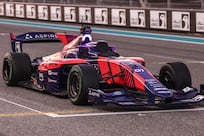Leaving home with no intention of returning is an act of rebellion, of rebirth and, for many, a rite of passage," ruminates the Berlin-based American curator Emilie Trice. "The bizarre characters, the trials of faith and the dangers that dominate the unknown become a kind of magnifying glass, emphasising the absurdity and the beauty that can only exist beyond the familiar."
To give voice to this yearning for new truths, Trice has enlisted 10 of Berlin's top artist transplants in creating Highway Child, a collective ode to the lure of wanderlust and the captivating cool that summons international artists to take root in her adopted city. Housed in Friedrichshoehe, a former 19th century brewery which is now Berlin's newest and freshest cultural centre, with 900 square metres of raw industrial exhibition space, Highway Child takes its title from Jimmy Hendrix's homage to rolling-stone ramblings.
Personally and artistically, Trice has tapped into Berlin's appeal for restless young people ousted from other classically creative European cities by staggering rents and stultifying gentrification. After leaving the Gagosian gallery in New York City in 2006 to open the Berlin branch of New York's Goff and Rosenthal gallery, she quickly became a kingpin figure in Berlin's artistic expat scene. For Highway Child, Trice presents work by Artists Anonymous, Alec Soth, Brendan Flanagan, Ethan Hayes-Chute, Kenno, Hannes Bend, Jaybo, Maxime Ballesteros Biguet, Nacnud Ogaviz, Pete Wheeler and Warren Neidich. Their shared impulse toward movement and velocity is exemplified by Hannes Bend's life-size sculpture of a jack-rabbit. But while the rabbit's body has the same dense range of deep reds as Marc Quinn's 1991 frozen sculpture Self, where the artist's head was fashioned from 4.5 litres of his own blood, Bend's rabbit is constructed of ruby-coloured hard candy. Even for viewers without jack-rabbit-like jitteriness in their blood, merely standing near that sugary substance could create an itchy energy rush fuelling the desire to jump off to the next destination.
In contrast to Bend's energising work, the major American photographer Alec Soth captures the potentially exhausting and disheartening effects of rootlessness in a small and striking image. Soth's raw, folkloric pictures of his home state of Minnesota earned him international attention after he was admitted into the 2004 Whitney Biennial, the premier showcase for American artists, which is organised by New York's Whitney Museum of American Art. For Highway Child, Trice selected a photo of a soiled mattress floating on top of grey storm water towards a mangy patch of reeds. The image resonates with an ominous sense that the place where you rest your head can be uprooted and unmoored at a moment's notice.
Another Whitney Biennial veteran in the show is Warren Neidich, whose brilliant sun-bleached photos of American rest stops and roadsides are presented as a slide show projected against a broad screen in the massive industrial exhibition space's centre room. Neidich is a Berlin and London-based artist and scholar whose academic writings on art and science have appeared in high-minded catalogues under titles such as The Neurobiopolitics of Global Consciousness. But the images that Trice cherry- picked from Neidich's 1995 On the Road series are marked by a graceful simplicity. Many of the disorienting and lyrical photos in the series pick out the word "self"from the self-service signs that can be found throughout America's open roads and highways. One such photograph shows two signs on pumps at a worn-down gas station. But Neidich's compositional arrangement of the faded lettering summons up a traveller's hope for self-discovery through the journey that the gasoline will enable.
Lovely louche hipsters in Maxime Ballesteros Biguet's high-contrast black and white photographs represent a roving class of nomads - the scrappy, scruffy and sexy young people who gravitate to cities with cheap housing and form ad hoc communities. Ballesteros Biguet's images have the swagger of Larry Clark and the grit of Corrine Day, they also share with these masters of dirty realist photography the rare moments of pathos and genuine intimacy that are captured when a talented insider chooses to document her outsider peers. Ballesteros Biguet's images of a ragtag rabble of beautiful drifters who have made a home with each other call us to leave our nests and venture forth without a destination. Though, as Highway Child demonstrates, for artists of all backgrounds and temperaments, Berlin has proved itself an ideal location to stop rambling and take root.




